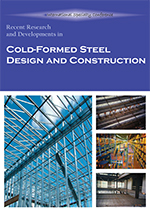Session Dates
24 Aug 2012 - 25 Aug 2012
Abstract
Innovative cross-section shapes for built-up columns from cold-formed steel (CFS) profiles are evaluated experimentally. The goal is to obtain highly stable members with reduced sensitivity to bucking effects and initial imperfections, and therefore, higher strength-to-weight ratios. The columns have been designed following the principles of the direct strength method [1], with the ambition to exclude (or reduce) various buckling effects from the column response to compressive loads. Cross-section proportions and bolt spacing have been adapted, in order to interfere with the distortion of individual profiles and the overall buckling of the columns. Experiments show that, through proper design and insight into the behaviour of such members, columns with substantially increased overall capacity can be obtained. The good agreement between predicted and measured ultimate loads also indicates that such built-up assemblies could be integrated into everyday construction practice.
Department(s)
Civil, Architectural and Environmental Engineering
Research Center/Lab(s)
Wei-Wen Yu Center for Cold-Formed Steel Structures
Meeting Name
21st International Specialty Conference on Cold-Formed Steel Structures
Publisher
Missouri University of Science and Technology
Document Version
Final Version
Rights
© 2012 Missouri University of Science and Technology, All rights reserved.
Document Type
Article - Conference proceedings
File Type
text
Language
English
Recommended Citation
Georgieva, Iveta; Schueremans, Luc; Pyl, Lincy; and Vandewalle, Lucie, "Innovative Cross-section Shapes for Built-up CFS Columns. Experimental Investigation" (2012). CCFSS Proceedings of International Specialty Conference on Cold-Formed Steel Structures (1971 - 2018). 4.
https://scholarsmine.mst.edu/isccss/21iccfss/21iccfss-session2/4
Innovative Cross-section Shapes for Built-up CFS Columns. Experimental Investigation
Innovative cross-section shapes for built-up columns from cold-formed steel (CFS) profiles are evaluated experimentally. The goal is to obtain highly stable members with reduced sensitivity to bucking effects and initial imperfections, and therefore, higher strength-to-weight ratios. The columns have been designed following the principles of the direct strength method [1], with the ambition to exclude (or reduce) various buckling effects from the column response to compressive loads. Cross-section proportions and bolt spacing have been adapted, in order to interfere with the distortion of individual profiles and the overall buckling of the columns. Experiments show that, through proper design and insight into the behaviour of such members, columns with substantially increased overall capacity can be obtained. The good agreement between predicted and measured ultimate loads also indicates that such built-up assemblies could be integrated into everyday construction practice.



